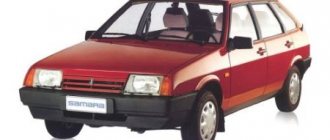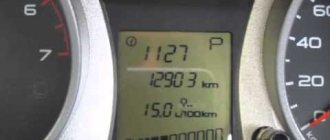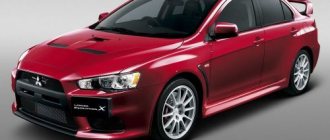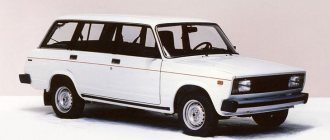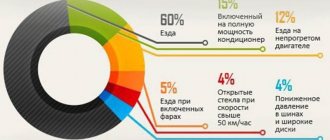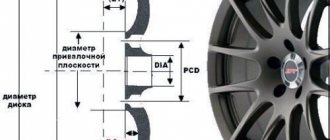Fuel consumption is a serious issue for the vast majority of motorists. First of all, it is relevant for owners of budget cars, which include the VAZ-2114. Considering that today the cost of gasoline is quite high, it is easy to guess that increased consumption can make a noticeable hole in the family budget of an ordinary person, when every trip becomes literally golden.
According to the manufacturer’s documentation, the “fourteenth” consumes from 8 to 9 liters of fuel per 100 kilometers. Of course, a lot depends on the driving style - with an aggressive driving style, fuel consumption increases. In addition, there will also be different numbers on the highway and in the city. However, there is a guideline, so it is not difficult to draw a conclusion about whether the fuel consumption of the VAZ-2114 is normal or too high. Naturally, if a car consumes too much gasoline, the problem should be corrected as soon as possible.
FACTORY SPECIFICATIONS
In any case, the fuel consumption of the VAZ 2114 per 100 km depends on the operating conditions of the vehicle. This indicator also affects the characteristics of the engine. It must be taken into account that the VAZ model was equipped with 4-cylinder engines:
- Volume 1.5 liters, 8 valves;
- Volume 1.6 liters, 8 valves;
- Volume 1.6 liters, 16 valves.
Table of gasoline consumption per 100 km. (according to data from the car manufacturer VAZ)
Therefore, the fuel consumption of a VAZ should differ slightly according to factory conditions in different modes, depending on the displacement of the engine and the number of valves in the cylinder head.
Certified fuel consumption of a VAZ-2114 car
Average fuel consumption on the on-board computer screen
The fuel consumption of any modern car is assessed according to three protocols - fuel consumption in the city, on the highway and consumption in mixed mode.
Due to the fact that several types of engines were installed on the second Samara, fuel consumption also depends on this. AvtoVAZ provides the following figures:
- The 1.5-liter 8-valve engine consumes 8.2 liters in the city and 6.2 liters on the highway;
- The 1.6-liter 8-valve engine also requires at least 8.2 in the city and 6 liters on the highway;
- A 16-valve engine with a volume of 1600 cubic meters will require 8 liters in the city, and 6 liters per hundred on the highway;
- The 98-horsepower 1.6-liter 16-valve engine consumes 7.3 liters in the city, and suburban consumption remains at 6 liters per hundred.
The consumption is relatively small, but it may be far from reality. The fact is that the amount of fuel consumed is influenced by a lot of factors related to both the quality of gasoline, the technical condition of the car, and the operating features.
Fuel consumption at idle speed
And this is also a fairly significant indicator when determining average fuel consumption.
The passport idling flow rate should not exceed 0.8 liters per hour.
Since our engine is not a carburetor and you can’t adjust anything with a screwdriver, the only thing to blame for the high consumption is the idle speed sensor.
The idle speed sensor affects average fuel consumption
Unfortunately, this sensor cannot be diagnosed in any way, so its failure can only be judged by its symptoms:
- no high revs during cold starts;
- unstable, floating idle speed;
- refusal to idle in principle;
- The engine stalls while coasting or while shifting gears.
Actually, there is only one treatment option - replacing the sensor . However, there is another sensor that is diagnosed by the system - the throttle position sensor. It is located in the throttle assembly and the symptoms of its malfunction are similar to the idle speed sensor. The only difference is that its malfunction will be detected by the self-diagnosis system.
Fuel consumption at idle speed VAZ 2114
Greetings, dear friends!
Gone are the years when you could fill up almost a full tank of gasoline with 50 rubles. Those of you who can even vaguely remember that time know what I mean. Agree, few people cared about the fuel consumption of their own vehicle, but what they could afford. Today, in the 21st century, we have a completely different situation; the global crisis forces us to save money not only on gasoline, but even on bread. So the modern driver has to closely monitor all the mechanisms that in one way or another affect the final figure of gasoline spent. Moreover, this factor has become one of the key ones when buying a car. And that is why many car enthusiasts with average incomes choose the domestic “fourteenth” model of the “Zhiguli”. The fuel consumption of the VAZ 2114 does not differ in super-minimum figures, but the figure does not exceed the level set many years ago by AvtoVAZ. However, if certain units fail, the factory standard may increase significantly. Of course, for a timely response, you need to know not only the declared consumption, but also the real one, because they may differ slightly from each other. I propose to fill this gap by reading the article to the end, and I also have some tips for you on how to reduce gasoline consumption. But first things first.
A brief historical excursion for connoisseurs
The main differences in appearance are as follows: original headlights, additional brake light, new spoiler, etc. As for the “filling”, there have been many more changes:
- the europanel device is a front panel with two LCD displays, equipped with an overboard thermometer;
- convenient placement of emergency information in the center of the panel;
- optimal interior ventilation;
- steering column adjustment;
- heated seats;
- electric windows;
- folding rear seats.
Considering all of the above, the owners of the VAZ 2114 can only be envied. The ride quality is stable, the control unit is reliable, the steering wheel no longer blocks part of the dashboard and leaves enough space for the driver to sit comfortably.
If necessary, you can easily convert your hatchback into a station wagon by simply folding the rear seats. Thus, the car becomes a utility vehicle with a large body capacity. Comfort is also an undoubted advantage due to the same heated seats and thoughtful ventilation.
All this sounds great, and it would be so if not for one big drawback - the fuel consumption of the VAZ 2114. The reasons may be different, and they will be discussed further. But the fact remains: sometimes 10 or even 13 liters of gasoline are needed per 100 km, which cannot but upset car owners. Fuel consumption is actually high. Since it is necessary to protect lovers of the domestic automobile industry with all our might, we will try to understand the issue and find a way out.
The principle of operation of the fuel system
High fuel consumption on the VAZ 2114, then follow the instructions below. Of course, few people would want to drive such an “expensive” car and throw money away. There are not many options: go to an official service center and let them fix the shortcomings, or do it yourself, if you know a lot about it. Only in the latter case you need to be especially careful, since you can violate the warranty period, if it still exists. So, if you decide to fix everything yourself, then first you need to outline the range of sources of problems: electronic control unit (ECU), sensors, filters.
Before taking specific steps, analyze the style and manner of driving your car, brand of fuel, average speed, geographic and climatic operating conditions. It would seem like a small thing, but it can significantly increase the car’s appetite by several liters in the plus position. Drive the car into an inspection pit or overpass, let the engine cool, put on rubber gloves and begin visual diagnostics.
Pay attention to the fuel system, namely:
- Unscrew the nozzles one by one. Examine them. If you have a tester, clean it with injector fluid. Possible deposits or other foreign particles;
- Fuel pump: if there are no leaks or mechanical cracks, then the cause may be internal. You should disassemble it and clean the internal diaphragm (see the article “Signs of a fuel pump malfunction”);
- Remove and replace the gasoline filter with a new one; if there is no obvious sediment in the old one, this does not mean that it is clean. Microparticles are not visible to the human eye;
- Malfunctions in the speed sensor. At first glance, it has nothing to do with it; it may be a source of increased gasoline consumption;
- Instability in the operation of the phase sensor, which records the position of the crankshaft at certain moments of rotation;
- The oxygen sensor allows less air to pass through. The fuel system begins to starve, the mixture becomes leaner and the engine requires more ignition costs. In this case, only complete replacement, no resuscitation;
- In addition to the fuel system, we will check other components. Each part must be checked separately, so that you do not spend money on purchasing the entire set, but it turns out that the filter, for example, is to blame.
- The air filter is the second source after the fuel system. It can squeeze out a maximum of 3.0 liters/100 km. mileage
We recommend: The best inexpensive winter studded tires
Think about it, maybe it’s better to change it in time, especially since it costs a penny. And the replacement process is not complicated at all; even a schoolchild can do it without any special skills.
Spark plugs: after unscrewing them one by one, we carry out a visual inspection. An ideal candle will have a light brownish tint; all other colors are considered a malfunction. Red, black, soot, white soot are symptoms of instability in work. There are two options: either completely replacing the spark plugs or cleaning them with a household cleaner and checking the gaps between the electrode and the tip. Electrical integrity: This primarily applies to high pressure wires. Damaged ones can shoot onto the housing, thereby weakening the spark in the combustion chamber. Age and condition of the engine: perhaps the compression level is below normal or there is none at all. Check with a compression gauge and compare the data with the instructions; A simple reason is the tire pressure, which also needs to be checked with the operating instructions. As we see, there can be many reasons why the VAZ 2114 has high fuel consumption, but they can be eliminated both in a garage and in a car service center. Choose a method and go for it.
Possible reasons for increased fuel consumption of VAZ-2114
Any problem in a car always arises due to a malfunction of some component or part. The situation when fuel consumption suddenly increases is no exception to the general rules. There are also a number of underlying reasons, both simple and complex. These are, in particular:
- low pressure in the fuel system due to a faulty fuel pump;
- filter contamination - fuel or air;
- problems with sensors - speed, camshaft position, oxygen supply;
- dirt in the injectors.
VAZ 2114 at idle fuel consumption
Greetings, dear friends! Gone are the years when you could fill up almost a full tank of gasoline with 50 rubles. Those of you who can even vaguely remember that time know what I mean. Agree, few people cared about the fuel consumption of their own vehicle, but what they could afford. Today, in the 21st century, we have a completely different situation; the global crisis forces us to save money not only on gasoline, but even on bread. So the modern driver has to closely monitor all the mechanisms that in one way or another affect the final figure of gasoline spent. Moreover, this factor has become one of the key ones when buying a car. And that is why many car enthusiasts with average incomes choose the domestic “fourteenth” model of the “Zhiguli”. The fuel consumption of the VAZ 2114 does not differ in super-minimum figures, but the figure does not exceed the level set many years ago by AvtoVAZ.
However, if certain units fail, the factory standard may increase significantly. Of course, for a timely response, you need to know not only the declared consumption, but also the real one, because they may differ slightly from each other. I propose to fill this gap by reading the article to the end, and I also have some tips for you on how to reduce gasoline consumption. But first things first.
The truth is in the numbers
So, the amount of gasoline consumed over a period of 100 km is an indicator of fuel consumption by your car, which is directly influenced by the technical characteristics of the car’s power unit. The most popular injector on the VAZ 2114 is the 1.5 (78 hp) and 1.6 (81 hp) liter engine. Accordingly, the consumption of these models differs slightly; the difference is clearly visible in the photo. Also, the design of such a power unit may have 16 or 8 valves, but this does not change anything in our question. Like other models of four-wheeled vehicles, the “fourteenth” demonstrates minimal consumption on the highway. If you control the speed within 70-90 km/h, you can achieve the level of small cars - 5 liters. As for driving around the city, it all depends on your driving style. An experienced conqueror of the streets of a metropolis will not spend more than 10 liters over the same 100 kilometers, but in another case, the “appetite” can grow to “Volgov” 13-14 liters. The photo above shows the declared average, maximum and minimum consumption levels of both engine types. Oddly enough, the actual consumption is not much different from the factory one.
Many drivers are often interested in how much power a car consumes at idle speed? As for measuring spent gasoline while standing, the measurement procedure is completely different. Here we cannot use a kilometer segment, but only a time one. Therefore, the usual 100 km replaces one hour of engine operation. "VAZ 2114" for the allotted period of time consumes no more than 1-1.3 liters of gasoline. If this number is higher, pay attention to the idle speed sensor.
The main culprits of overspending
If fuel consumption increases sharply, the first thing to do is check the filter. Debris in the fuel or air filter can significantly increase gasoline consumption. What can we say if even low tire pressure leads to the same result. But the main reason for the “gluttony” is the sensor. He is not the only one in the VAZ 2114 device, so let’s dwell on this point in more detail. Increased consumption may be caused by a malfunction of the following devices.
- Lambda probe - installed in the exhaust system, it regulates the working mixture. Most often, the device fails due to low quality gasoline, incorrect mixture, pinched valves, broken oil rings, and an incorrectly set advance angle.
- Speed sensor - if traction has dropped, idle speed is floating, the speedometer is unstable, and fuel consumption is high, then it is most likely to blame. You can find it on the top cover of the gearbox.
- Phase sensor – we discussed all the nuances of this device in the previous article.
- Electric fuel pump - the symptoms are still the same. You can accurately determine whether there is a problem with it using a pressure gauge.
- Injectors - failures during acceleration, low engine dynamics symbolize their clogging.
REAL PETROL CONSUMPTION ON VAZ MODELS
Real fuel consumption on the VAZ 2114 (as well as on the VAZ 2113 and 2115) often differs from the factory values. Mainly differs in the direction of increase. Of course, a lot depends on weather conditions. In winter, due to long and frequent warm-ups of the car, gasoline consumption increases, and other factors also influence fuel consumption:
- Driving style. Driving with sudden acceleration and high speed does not save fuel;
- Various malfunctions: in the engine, in the ignition system, in the fuel system, etc.;
- Unregulated tire pressure;
- Driving on a cold engine;
- Fuel quality.
It is necessary to take into account that the fuel consumption of the VAZ 2115 (2113) is practically no different from the gasoline consumption of the 2114 model, since the cars have very similar characteristics and are equipped with exactly the same engines.
The main signs and reasons for the increase in fuel consumption of the VAZ 2114
If it’s summer and you drive on normal roads, but at the same time you notice an abnormal “appetite” of the fuel-injected 8-valve VAZ 2114, then it’s time to conduct a full diagnosis of the car’s condition. Excessive fuel consumption is easy to notice not only by the frequency of visits to gas stations. Often, owners note some oddities in the operation of the engine. Unstable operation of the “heart” of the car is accompanied by black smoke from the exhaust pipe and the presence of popping noises in the muffler or intake manifold.
Black smoke from the exhaust pipe most often occurs due to the formation of an overly rich fuel mixture. This disease occurs due to clogged injectors, faults in the ECU, and low-quality spark plugs.
Gasoline consumption can increase, both for a simple and harmless reason, and in the event of serious malfunctions in the car system. For example, a clogged fuel filter increases the fuel consumption of the “fourteenth” by as much as 2-3 liters. Low tire pressure and non-standard wheel radius also contribute. It has long been a known fact that the larger the radius of the wheel, the more effort must be made to turn it.
Other reasons for excessive fuel consumption include:
- malfunction of the oxygen supply sensor;
- low level compression;
- problems with the air flow sensor;
- late ignition, clogged catalyst.
In any case, it is necessary to comprehensively diagnose all car systems, and then, based on the detected problems, select the most effective ways to eliminate them.
Sensors and electronics that affect flow
If everyone knows the location of the wheels, then where the mass air flow sensor is located in the VAZ-2114, for example, not everyone knows. But this is not the only sensor on which flow directly depends . There are enough of them:
- throttle position sensor;
- idle air control;
- Lambda probe;
- idle speed sensor;
- speed sensor.
Throttle position sensor
Mass air flow sensor
Speed sensor
Lambda probe
Idle speed control
And in general, all control electronics on VAZ fuel-injected cars are prone to tricks. Even such a not-so-subtle device as a gas pump can seriously affect consumption. On the VAZ-2114 it is electric, and most of the parts are made of plastic, which indicates a small resource.
When the pressure in the power system drops, the flow rate will increase very noticeably.
It’s easy to check its operation - there is a place on the fuel rail to connect a pressure gauge, the normal pressure is 370-400 kPa . But if you have these symptoms:
- instability at idle;
- drop in power at high speeds;
- high CO content in exhaust gases;
- the motor is unstable,
you should check the pump on the stand.
Eliminating the first cause of high fuel consumption
It is worth dwelling in more detail on ways to eliminate the first and second reasons for high fuel consumption on the Lada Samara-2. So, on-board computer. When dealing with electronics, you need to be very careful and attentive, even if you are theoretically savvy and can ask the right questions to the technicians. The part that you can safely take on is checking the mass air flow sensor. First of all, you need to make sure that the sensor is actually faulty and the increased fuel consumption of your car is associated with it. To do this, you should turn it off and drive like this for a while. If you feel that the car has begun to move easier and more vigorously, do not rejoice, because the mass air flow sensor is really coming to an end.
A VAZ 2114 with an engine, for example, 1.5 liters, up to 1000 rpm consumes about 10 kg of air per hour, at 2000 it already reaches 21 kg. If these figures are lower, it means that fuel consumption is lower, although this cannot but affect the dynamics of the engine. But if the standard is exceeded, fuel consumption increases accordingly. And don’t let the increase in dynamics in this case console you, since starting the car in low temperatures will be very difficult, if not impossible.
A difference of even 2 kg upwards can lead to the entire electronic system constantly freezing, you will get nervous, turn off the sensor completely and drive in emergency mode. This is hardly pleasant and convenient, so diagnosing the air flow sensor is your first task.
We recommend: Why and how often to refill your air conditioner. How risky is it to do such a procedure yourself?
Unscrew it and use a tester to measure the voltage with the ignition on (the engine is not running). With an operating range of 2 Volts, 1.01 and 1.02 are a good sign, which means the sensor is in order. At 1.04, you don’t have to think any further - just replace the sensor with a working one. Of course, all cars are individual, the indicators may differ slightly, but the principle of diagnosis and testing is generally unchanged.
Possible reasons for increased fuel consumption of VAZ-2114
Any problem in a car always arises due to a malfunction of some component or part. The situation when fuel consumption suddenly increases is no exception to the general rules. There are also a number of underlying reasons, both simple and complex. These are, in particular:
- low pressure in the fuel system due to a faulty fuel pump;
- filter contamination - fuel or air;
- problems with sensors - speed, camshaft position, oxygen supply;
- dirt in the injectors.
Wheels also play a very important role here. Tire pressures that are too low or too high can lead to increased fuel consumption.
In addition, the non-standard wheel radius is another possible reason for the car’s increased appetite.
As you can see, there are quite a lot of reasons. In order to find out exactly why consumption has increased, you should gradually go through the possible options, one after another. At the same time, experienced car enthusiasts advise always doing this, guided by the principle from “simple to complex.” So, first of all, we measure the tire pressure. Wheels with a larger diameter, of course, look more beautiful, but do not forget that turning it will require more serious effort. The result is increased fuel consumption. The next possible reason is a clogged fuel filter. It must be checked for debris inside. By the way, do not forget to change this filter in a timely manner. It is inexpensive, while the dirt that accumulates inside can increase the consumption of the “fourteenth” by 2-3 liters.
If no problems are found here, we move on to inspecting the sensors that affect fuel consumption. In particular, pay attention to the lambda probe. Many people probably know that it evaluates the presence of oxygen in the exhaust gases and ensures correct adjustment of the supplied fuel mixture. An error in the operation of the oxygen sensor can be detected at a service station by going through the diagnostic procedure, or the on-board computer will give you a hint. As a rule, it fails due to low-quality gasoline, incorrectly set advance angle, oil getting into the mixture through oil scraper rings, and clamped valves.
Next, you should check the performance of the speed sensor. It is located on the gearbox, in its upper part. This sensor transmits information about the speed at which the car is moving to the control unit, on the basis of which the engine operation is controlled. Its malfunction can also be guessed by a number of accompanying signs:
- increased fuel consumption;
- complete failure of the speedometer, or interruptions in its operation;
- floating speed in idle mode until the engine stops;
- clearly decreased traction.
The next stage of testing is the phase sensor (camshaft). The fact that there are some problems in its operation will be indicated to you by the Check Engine sign that lights up on the dashboard. In addition, consumption will increase, car dynamics will noticeably deteriorate, and failures will begin to occur in self-diagnosis mode.
The serviceability of the fuel pump is also a very important factor. During operation, its parts gradually wear out, and this ultimately leads to a decrease in pressure in the fuel system. In order to understand whether the problem is really in the fuel pump, you should take a measurement by connecting a pressure gauge to the fuel frame. Also pay attention to this node if you have the following symptoms:
- engine stalling at idle;
- power reduction;
- appeared adjustment;
- increased consumption.
Dirt clogging the injectors also increases the car's appetite. Many people probably know that they should be cleaned periodically. This can be done by contacting a car service. It is not recommended to do this yourself - unless you have the appropriate skills. You will be alerted to the presence of a problem with the injectors by increased consumption, dips that are clearly felt when accelerating, and deterioration in dynamics.
If you notice increased fuel consumption at idle, you should also check the sensors. Normally, the “fourteenth” should consume from 0.8 to 1 liter per hour here. If your number is high, first check the idle speed sensor. It is located on the throttle body cover. The best option for testing is to install a known working sensor. The fact that the problem is here will be indicated to you by floating speed at idle and the engine stalling in neutral. Also pay attention to one thing. When starting a cold engine, the speed should be higher than when starting a warm engine. If this is not observed, then there is every reason to check the DXX.
Gasoline consumption may also increase for other reasons, such as low compression, incorrect adjustment of the gas distribution system, or incorrectly set ignition timing. Don't forget to also check the throttle position sensor, spark plugs and high-voltage wires.
How to reduce gasoline consumption on a VAZ 2114?
What to do if fuel consumption in the VAZ-2114 has risen above normal? The factory documentation states that fuel consumption for this brand is 8.9-9.0 liters per “hundred” when driving around the city. In practice it turns out more. What actions should you take to reduce gasoline consumption? Below we will look at how to quickly and reliably achieve your goal.
Content
Check the ECU
Increasing the “gluttony” of a car is not a reason to despair. The first thing to start with is to check the functionality of the fuel supply system. To solve the problem, understand the theoretical part. So, the ECM is an electronic system that controls the operation of the motor. This complex includes a group of nodes - the vehicle's ECU (electronic control unit), as well as sensors that collect information about the state of the nodes and transmit them for processing.
If any of the components malfunctions, the ECU displays an error, which is indicated by the “Check Engine” lamp lighting up on the dashboard. The difficulty is that the car owner only sees the fact of the problem. He cannot determine which part failed. To decrypt, special testers are used that read the code and provide complete information about the malfunction.
If the result confirms fears about the failure of the fuel system, carry out repair work and replace faulty components. Thanks to such actions, it is possible to reduce gasoline consumption and prevent more serious breakdowns. But what to do if all the indicators are normal, there are no error codes, and the sensors are working properly? In such a situation, start looking for another reason.
Study the technical characteristics and condition of the components
- First, check the air filter. If it is clogged or is due for replacement, install a new filter.
- Assess the condition of the spark plugs for contamination and the appearance of soot. If there are problems, clean the electrodes or replace the faulty element (about replacing spark plugs).
- Also check the ignition system wires. If the insulation is damaged or there is a spark breakdown to ground, repair the old ones or buy new wires.
- Now measure the compression and determine whether the valve timing is correct. An important point is the ignition timing, which, when properly adjusted, can also reduce gasoline consumption. The key parameter is the pressure in the fuel supply system. If it is reduced or increased, then this inevitably leads to increased “gluttony”.
- Pay attention to the injectors and check them for adequate flow rates.
- If the car is more than five years old, reflash the ECU (it is better to entrust the work to professionals).
What can really help reduce fuel consumption?
ON-BOARD COMPUTER
A useful thing for a car enthusiast is an on-board computer (Installing an on-board computer). The device, online, transmits the most important information for the driver - instantaneous fuel consumption, distance traveled, speed and other parameters. When you press hard on the gas, fuel consumption increases from 20 to 30 liters per “hundred”. Seeing such indicators on the display, you will definitely change your driving style. At the same time, it is possible to solve two problems - reduce gasoline consumption and make travel safer. Remember that aggressive driving, with a sharp increase in speed, increases the “gluttony” of the engine by an average of 20 percent.
DRIVING STYLE
The best driving option is to start smoothly, avoid sudden pressure on the gas pedal and avoid engine braking (the latter increases consumption by 3-5 percent). Also look at the engine warm-up sensor. If you start driving with a cold engine, fuel consumption increases by 10 percent.
TIRE PRESSURE
While operating the car, monitor the tire pressure (what pressure should the tires be?). If this indicator decreases, pump up the tires. If the pressure is optimal, then add another 0.3 bar. In this case, the tire life increases and gasoline consumption is reduced.
ENGINE OIL QUALITY
Pay attention to the quality of the engine oil - it must have the required characteristics. Experts recommend using “semi-synthetic” from trusted manufacturers who value reputation. It has been proven that using good oil also reduces consumption.
What not to do
Many car owners, in pursuit of solidity and better cross-country ability, install wheels of greater width and height. As a result, rolling resistance increases, but fuel consumption also increases.
A popular way to save money for many is to buy gasoline with a low octane rating (contrary to the manufacturer’s recommendations). In such a situation, it will also not be possible to save money.
Practice has shown that the ratio of costs and mileage for the two types of fuel (AI-80 and AI-95) is approximately identical. At the same time, the use of low-quality fuel also reduces the service life of the engine. Therefore, filling the tank with bad or leaded gasoline is not recommended. If you take a risk, the ECU will detect incomplete combustion of the combustible mixture, which will increase the volume of fuel supplied to all cylinders.
About additives to reduce fuel consumption
Many car owners set the goal of reducing gasoline consumption at any cost. But the above actions do not always have an effect. The modern market is saturated with numerous additives, the addition of which to oil or fuel supposedly leads to savings. But such products can not only be ineffective, but also dangerous for the engine.
Today, additives are sold that are recommended to be added to gasoline, oil and the combustion chamber. In case of excessive engine wear, the use of such compounds can reduce friction, equalize compression in all cylinders and even increase engine power. But the main issue, which concerns reducing fuel consumption, cannot always be resolved. Using additives on a new or used engine is dangerous, because it often leads to the breakdown of an expensive component and the need for repair.
Another way to improve engine performance is to add special “power capsules” to the combustion chambers. According to the manufacturers, under the influence of high temperatures, the product melts and covers the metal surface of the piston with a protective layer. It is believed that such optimization leads to an increase in compression by 3-4 kg/sq. centimeter. In addition, the engine power increases (up to 15%) and its service life is extended by 2.4 times. It is also possible to reduce gasoline consumption by 17-21 percent. But remember that here you act at your own peril and risk.
Today, there are manufacturers producing coolant modifiers, the action of which is aimed at improving heat transfer and reducing the temperature of the walls of the combustion chamber. In addition, such products solve a number of other problems - they optimize heat transfer, restore thermal gaps, reduce fuel consumption and increase the volume of air in the incoming combustible mixture (this is achieved by reducing exhaust gases). The additive is added to the expansion tank through a special cap for adding coolant.
Some car owners decide to tune the throttle assembly - cutting special grooves in it. As a result, the composition of the incoming fuel is optimized and the pressure of the forced air flow increases. It is believed that this modification can reduce gasoline consumption by almost 20 percent. The downside is that the technique is new and not fully studied. For this reason, there are not many people who want to try it on themselves. And there are no positive reviews about the results yet.
A popular way to save on fuel is to add special additives (additives) to the engine oil. The action of the latter is aimed at reducing friction of moving engine elements and restoring worn elements. At the same time, the manufacturer creates additives based on ceramic reduction, nanotechnology and other things.
Results
Operating practice and common sense show that to really reduce gasoline consumption, simple manipulations are enough - timely replacement of consumables, adjusting the main parameters of the car (including circuit voltage, under different engine operating modes) and careful driving. At the same time, there is no need to make structural changes. If there is high fuel consumption, start by checking the system responsible for the fuel supply. Attention to the VAZ-2114 car and its proper operation is a guarantee of reliability and efficiency.
